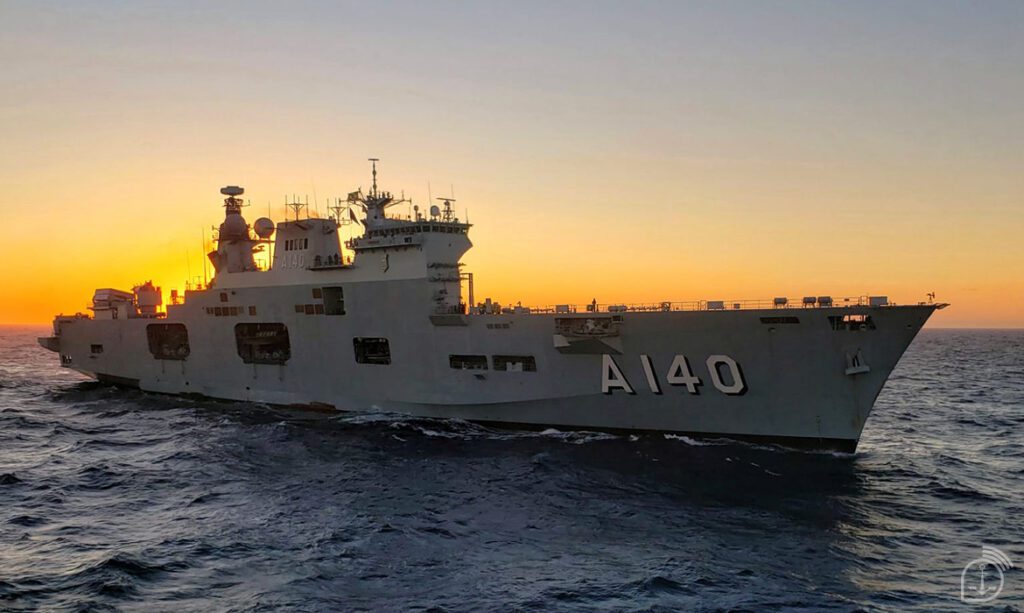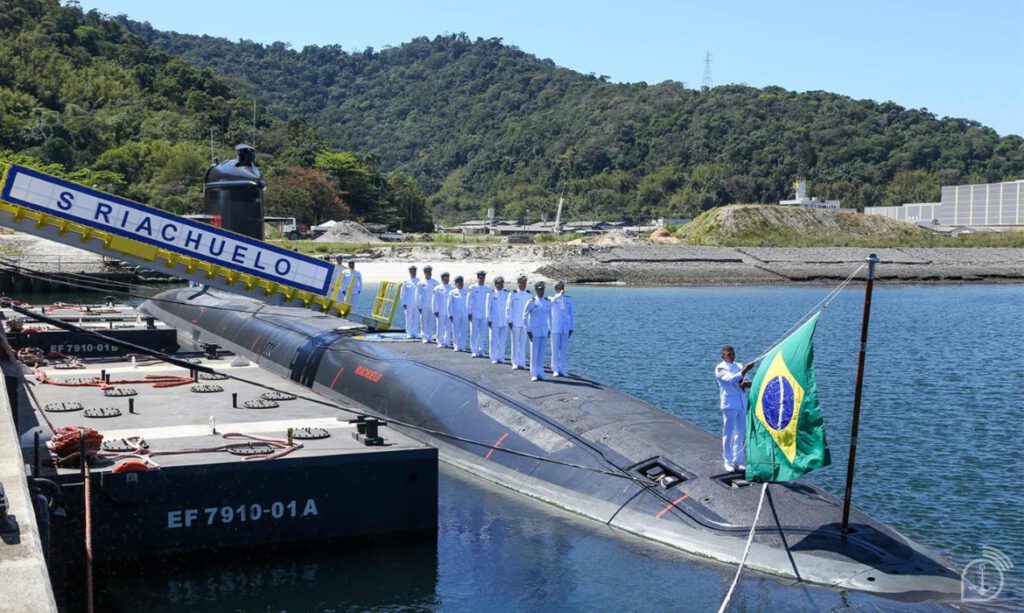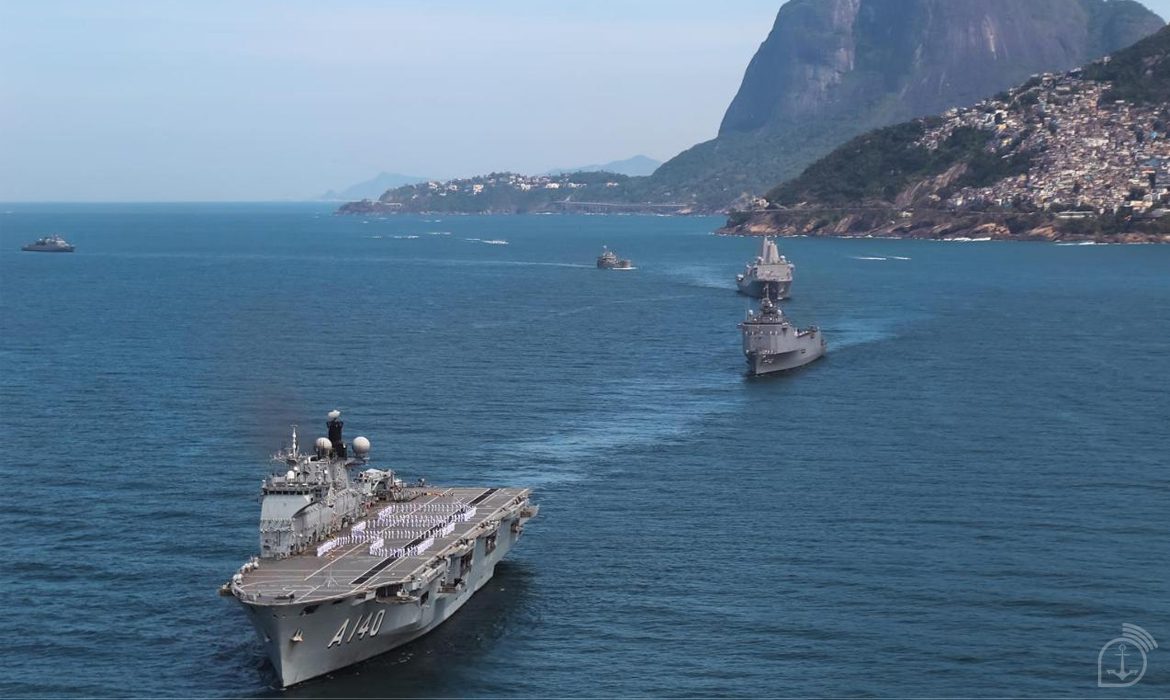Military and religious ceremonies are among the celebrations of the 200th anniversary of creation
By Agência Marinha de Notícias – Rio de Janeiro, RJ
This Thursday (10), Brazil celebrates a historical date: the bicentennial of the creation of its Fleet. It was on November 10, 1822, that the National Flag was hoisted for the first time on a Brazilian warship, the “Martim de Freitas”, later renamed “D. Pedro I”, the first flagship of our Fleet. It was in the midst of several Portuguese oppositions that the now known Brazilian Squadron was born, which aimed to combat, at that moment, the naval forces opposing the independence process. To commemorate the date, today (10), a religious ceremony was held at the Candelária Church, downtown Rio de Janeiro, and a military ceremony was held aboard the Multipurpose Airship “Atlântico”, the current Captain of the Fleet.
As stated by the head of the Department of Maritime and Naval History of the Directorate of Historical Heritage and Documentation of the Navy (DPHDM), Frigate Captain Carlos André Lopes da Silva, in this process of territorial consolidation, it was necessary to create a structure to directly combat the action of the rebels. “The most important minister of the time, José Bonifácio, understood that the creation of a strong fleet, that is, the institution of a national naval power, would be the indispensable condition for Brazil to be able to face any military attempt of retaking control by the Portuguese at that moment.”
Still about this period, the doctoral student in history, politics, and cultural assets at Fundação Getúlio Vargas (FGV), professor Jéssica de Freitas e Gonzaga da Silva, also reinforces that it was strategic to have an active squadron, since we did not have roads at that time. “The defense of the sovereignty of the newly independent Empire of Brazil and the preservation of the territory’s integrity justified the immediate creation of the Brazilian fleet in 1822. The absence of roads amplified the strategic role of maritime communications to guarantee the transport of troops, the defense of international trade, the projection of power of the central government, and pacification, assuring Brazil’s continental dimensions,” reinforces the professor.
The Fleet today

Two centuries have passed and, since then, the Brazilian Fleet has remained with the same spirit of homeland defense and territorial unity. Besides all the material part of the Naval Force, the importance of the personnel involved must also be stressed, as emphasized by the Commander in Chief of the Fleet, Vice-Admiral Arthur Fernando Bettega Corrêa. “The human capital is essential for the full accomplishment of missions and is our greatest asset. Today’s Fleet is composed of men and women who work hard every day in the performance of their duties, in order to be in a position to defend our sovereignty and our interests in the Blue Amazon. There are many examples of our predecessors who, in these 200 years of rich history, defended our interests against powerful nations, when Brazil was present through the core of its naval power, the Fleet,” she said.
For Professor Jéssica, the projects developed by the MB are a differential in the maritime mentality of the nation. “Firstly, by continuing to promote an autonomous naval strategic thinking in order to achieve technological independence and have a robust program of construction of the core of Naval Power, among which, the continuity of the Submarine Development Program (PROSUB) stands out, The Submarine Development Program (PROSUB), the Surface Ship Development Program (PROSUPER), the Maritime Area Control Vessel Program, the Patrol Vessel Construction Program (PRONAPA) and the National Surface Anti-Ship Missile Project (MANSUP). These ambitious projects contribute to affirm the role of Naval Power in the international projection of the Brazilian State, especially by ensuring the denial of the use of the sea to the enemy and the dissuasive capacity in the face of contemporary threats,” he said.
Composition of the current Brazilian Fleet
The Fleet is the set of forces (composed of surface combat and support vessels, submarines and aircraft, incorporated into the Brazilian Navy), under a single command, for administrative purposes.
Currently, Brazil has in its Fleet a multipurpose airship, frigates, corvettes, submarines, combat vehicle landing ships, mobile logistical support ships, multipurpose dock, submarine rescue ships, aircraft and amphibious vessels, as well as instruction centers, bases and training centers, capable of performing various tasks.
The Fleet of the Future

Revolutionizing the Brazilian technology and naval industry, the Submarine Development Program (PROSUB) represents a significant technological advance in the country, based on intellectual capital, sensitive engineering and state-of-the-art technology, in addition to encouraging the defense policy, boosting personnel training and strengthening national sovereignty.
The Submarine “Riachuelo” (S40) is the first of a class of four conventional submarines with diesel-electric propulsion, which will allow for greater deterrence power in the 5.7 million km² of our Blue Amazon. To protect this heritage and ensure Brazilian sovereignty at sea, the MB invests in the expansion of its naval force, as is the case of the S40, an important element of surprise that is indispensable to deny enemy vessels access to national territory, increasing the deterrent power of the Brazilian Armed Forces.
To achieve this purpose, this type of ship takes advantage of its particular characteristics, notably its concealment capacity and its power to cause damage to adversary naval forces. They have advanced sensors – such as a sonar array and periscopes with night vision cameras – in addition to a combat management system equipped with modern and complex algorithms that allow the submarine to detect and classify targets at long distances.
For the construction of the Brazilian conventional submarines and, in the future, the submarine conventionally armed with nuclear propulsion “Álvaro Alberto,” a naval complex was built in Itaguaí (RJ), which has several facilities, equipment and specialized systems. Today, it is one of the most modern shipyards in existence, since the construction of submarines requires highly qualified labor and an industrial park equipped to enable the execution of the various manufacturing, commissioning, and testing activities.
All this requires the integration of sophisticated technologies, following rigorous norms and standards of quality and safety. Thus, Admiral Bettega states that “the Fleet is composed of professionally trained military and civilian personnel who are always seeking to recycle themselves, learning and developing new doctrines, tactics, and technologies, and who maintain high levels of training and readiness, which are essential to successfully fulfill the missions entrusted to them.
In addition to these submarines, the Brazilian Navy has also been conducting the “Tamandaré Class” Frigates Program since 2017, with the goal of promoting the renewal of the Fleet with four modern ships of high technological complexity, built in the country. The frigates will be versatile escort ships with high combat power, capable of countering multiple threats and designed to protect maritime traffic and deny the use of the sea, able to carry out missions to defend the Brazilian coast. In addition, they will also be employed in the patrol of Brazilian jurisdictional waters, with emphasis on the inspection and protection of economic activities, such as commercial activity, with the use of maritime transport, oil and fishing.
About two thousand direct jobs and six thousand indirect jobs should be generated at the peak of the ships’ construction with, at least, 30% of national content in the first ship, and 40% as of the second. This provides a gradual transfer of technology in naval engineering for the manufacture of military ships, as well as combat management systems, propulsion, and other subsystems that make up a warship.
The frigates are scheduled to be delivered between 2025 and 2028.
*** Translated by the DEFCONPress FYI Team ***
